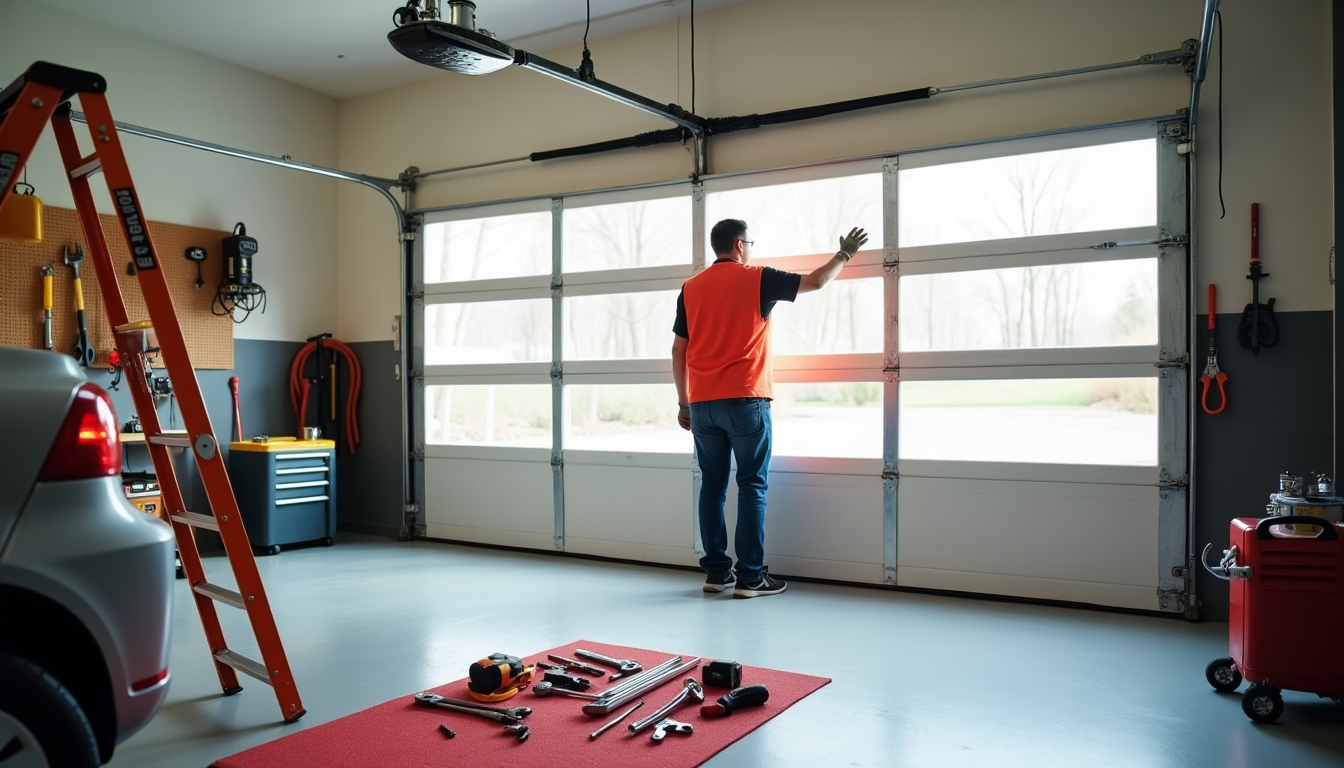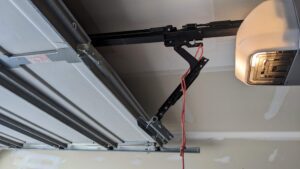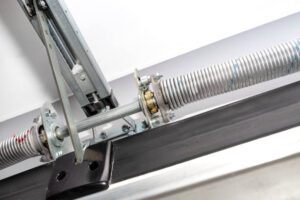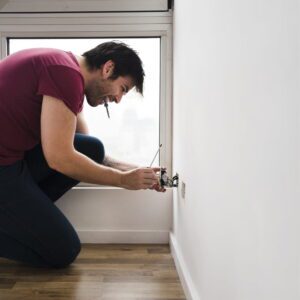How to Fix Garage Door Issues: A Homeowner’s Step-by-Step Guide

Your valuable home feature can quickly become a daily headache when problems arise.
Strange noises, erratic movement, and remote control problems plague homeowners everywhere. Broken springs, misaligned tracks, and obstructed sensors can cause garage doors to malfunction if you don’t maintain them properly.
These problems can disrupt your daily routine and cause endless frustration. We created this detailed guide to help you identify, troubleshoot, and fix common garage door problems. The steps in this piece will get your garage door working smoothly again.
Safety First: Essential Precautions Before Repairs
The numbers tell a scary story – garage door accidents hurt more than 15,000 people every year. Most of these accidents happen when people get pinched or crushed, and kids face the biggest risk.
Required Safety Equipment
You need the right safety gear before you start any garage door repairs. A complete safety kit has:
- Safety glasses to protect your eyes
- Durable work gloves
- Hard hat to protect your head
- Dust mask to keep you breathing safely
- Proper work boots
The power supply to your garage door opener must be disconnected before you start any repair work. This step keeps the door from moving while you work on it.
Understanding Garage Door Components
Your garage door works through a system of connected parts. The basic parts are high-tension springs, lifting cables, movement rollers, and guide tracks. The opener system also has safety sensors and auto-reverse mechanisms that help prevent accidents.
The torsion springs do most of the heavy lifting for doors that weigh between 100 to 300 pounds. These springs balance the door’s weight under extreme tension, which makes them dangerous to work with unless you have proper training.
When to Call a Professional
Some repairs should be handled by qualified technicians only. You should call a professional right away for:
- Spring system problems – these parts hold massive tension and can hurt you badly if mishandled
- Cable repairs or replacements – these are vital to keep your door balanced and safe
- Track alignment issues – your door needs proper alignment to work safely
- Motor and opener problems – these need special knowledge
- Damaged panels
Strange noises during operation, broken cables, spring issues, or roller problems mean you should get professional help. Trying advanced repairs without expertise will cost you more money and put your safety at risk.
Diagnosing Common Garage Door Problems
A systematic diagnosis is the foundation of garage door repairs that work. This methodical approach helps you find problems accurately and saves time and resources during repairs.
Visual Inspection Checklist
You should get a full picture of your garage door system with the power disconnected. A detailed visual inspection has:
- Track alignment and condition check
- Spring system examination
- Cable and roller assessment
- Hardware tightness verification
- Weather stripping evaluation
- Panel condition review
Clean the tracks with a damp cloth to remove debris that could affect your door’s operation. You should also check the weatherstripping at the bottom for cracks or damage that might affect your garage’s insulation.
Identifying Problem Sources
Garage door problems usually come from worn or damaged components. Your door’s balance is a key indicator of system health – disconnect the opener and lift the door halfway manually. The balance is correct if the door stays in place. If not, the springs need adjustment.
Listen carefully for strange sounds during operation. Worn rollers often make screeching or squeaking sounds, while loose hardware creates clicking or popping noises. A firecracker-like sound points directly to a broken spring.
Recording Symptoms
Good documentation gives you a clear picture of what’s wrong. Make sure to note:
- Door movement patterns (slow operation, partial opening, or reversal)
- Unusual sounds and their timing
- Visual signs of wear or damage
- Remote control and sensor responses
- Changes in door operation over time
These observations help both DIY repairs and professional service calls when tracked systematically. To cite an instance, misaligned safety sensors often cause the door to stop midway and reverse. A door moving slower than usual might signal roller problems or need lubrication.
Keep in mind that some symptoms need immediate professional help. An uneven door during operation typically shows serious spring system problems. A detailed record of these symptoms ensures you respond to potential issues at the right time.
Fixing Mechanical Issues
Mechanical problems are usually the root cause of garage door issues, from tracks that don’t line up to worn-out rollers. These problems might look overwhelming, but you can fix many of them with attention to detail and good maintenance.
Track Alignment Solutions
Tracks that don’t line up are one of the most common mechanical problems with garage doors. A properly aligned track will give a smooth door operation and prevents extra wear on other parts. Here’s how to realign your tracks:
- Loosen the screws holding the track to the frame
- Tap the bottom of the track gently with a rubber mallet
- Use a level to confirm vertical alignment
- Tighten all screws securely
- Test door operation for smoothness
You should keep a quarter-inch gap between the door and molding to stop rubbing. Bigger gaps can make the door bind or work erratically.
Spring and Cable Repairs
Important Safety Alert: Spring and cable systems work under extreme tension and you just need professional help. DIY repairs on these parts can cause serious injury. Watch for these warning signs of spring problems:
- A loud bang during operation
- Uneven door movement
- Door feeling heavier than usual
- Visible gaps in the spring coils
Without doubt, broken springs need immediate professional attention. The door’s cables work together with springs, and fixing them also needs expert knowledge. You should get professional help right away if cables show signs of fraying or damage to prevent door failure.
Roller Maintenance Tips
Good roller maintenance will extend your door’s life and keep it running quietly. We cleaned rollers with a damp cloth to remove buildup. Metal rollers with bearings just need garage door lubricant every two to three months.
Keep in mind, nylon rollers need different care – don’t use lubricant as it can harm the material. Time to replace rollers when you see:
- Visible cracks or chips
- Excessive wobbling
- Dried-out appearance
- Signs of rust or corrosion
You should do regular maintenance twice a year at least, more often in areas with harsh weather. This helps avoid surprise breakdowns and keeps your door working smoothly all year round.
Troubleshooting Electrical Components
Electrical components are the foundations of modern garage door systems. They need careful attention when problems occur. Knowledge of these components helps you spot issues quickly and will give a safe operation.
Remote Control Problems
Simple causes usually create remote control issues that homeowners can fix themselves. We found dead batteries cause most remote control failures. Remote batteries typically last about two years before they need replacement.
Signal disruptions can also prevent proper operation. Common causes include:
- Antenna Issues
- Check for debris buildup
- Ensure proper downward positioning
- Verify antenna isn’t damaged
- Range Limitations
- Stay within 20 feet of door
- Clear path between remote and opener
- Programming Problems
- Reset remote if unresponsive
- Reprogram after power outages
Sensor Issues
Safety sensors are significant safety components that prevent accidents by detecting obstacles. These sensors must line up correctly to work properly. The sending sensor shows an amber light, while the receiving sensor displays green when properly lined up.
Several factors can cause sensor problems:
- Dirt accumulation on sensor lenses
- Misalignment from daily activities
- Damaged or loose wiring connections
- Sun interference at specific times
Important Warning: Never bypass safety sensors because this can lead to serious accidents. Clean sensors regularly with a soft, lint-free cloth and ensure proper alignment.
Motor Diagnostics
Motor issues demonstrate specific symptoms that help identify the problem. The motor unit might experience problems due to:
- Power supply interruptions
- Capacitor failures
- Overheating during operation
You should first check the power source when diagnosing motor problems. Make sure the opener is properly plugged in and the circuit breaker hasn’t tripped. The capacitor, a small but vital component, stores and releases electrical energy to help the motor start and run smoothly.
Professional Attention Required: You need professional help if the motor shows signs of overheating or makes unusual sounds. These symptoms often point to serious issues that need expert diagnosis and repair.
A working motor should run quietly and smoothly. The motor might have a failing logic board or worn-out components if it runs but the door doesn’t move, or if it works intermittently.
Quick Fixes for Minor Problems
Regular maintenance can prevent major garage door repairs and save you time and money. Quick fixes of small problems will keep your door working at its best and make it last longer.
Lubrication Techniques
The right lubrication is vital for smooth garage door operation. We used silicone spray or white lithium grease because they work best for garage door components. These lubricants will prevent rust and reduce friction between moving parts when applied regularly.
Avoid Common Mistakes: Standard degreasers like WD-40 will attract dirt and create more problems. These products clean instead of lubricate and might remove the protective grease you need.
Apply lubricant to these specific areas:
- Hinges between door sections
- Steel roller bearings (avoid lubricating nylon rollers)
- Torsion springs and bearing plates
- Top rail where the chain travels
- Lock mechanisms
You should stick to a regular lubrication schedule every six months. Harsh environments might need more frequent application, especially when you have coastal areas nearby.
Tightening Hardware
Garage doors that open and close multiple times daily (1,000 to 1,400 cycles annually) will naturally have loose hardware. You should check all components before tightening anything.
Critical Warning: Leave red-painted hardware and bottom roller brackets alone – these affect your door’s safety and need professional attention.
Using a socket wrench or screwdriver, check and tighten:
- Track brackets
- Mounting hardware
- Roller brackets
- Hinges between panels
Don’t overtighten as this can damage components and speed up wear. Checking hardware twice a year prevents noise issues and keeps everything running smoothly.
Weather Seal Replacement
Weather seals protect your garage from the elements and reduce energy costs. You’ll know it’s time to replace them when they become brittle, crack, or leave visible gaps when the door closes.
Follow these steps for weather seal replacement:
- Remove old seal using a screwdriver or pry bar
- Clean the door groove thoroughly
- Measure and cut new weather stripping to size
- Apply penetrating oil to groove if insertion proves difficult
- Slide new weather strip into channel
- Trim excess, leaving four inches beyond door edge
- Fold excess back and slide into groove
Pick the right seal type based on your needs:
- Bottom Seal (U-shaped astragal)
- Threshold Seal
- Top and Side Seals
Quality weather seals block drafts, water, and pests from your garage. A proper installation will make your seal system work better and last longer.
Advanced Garage Door Repairs
Garage door repairs need precise knowledge and careful execution. Advanced repairs involve key components that affect your garage door system’s safety and how well it works.
Panel Replacement Guide
You need to replace panels when damage goes beyond surface-level repairs. Getting accurate measurements is vital for panel replacement success. The process needs you to:
- Measure panel dimensions precisely (width, height, thickness)
- Document manufacturer and model details
- Verify color matching with existing panels
- Identify joint types and hinge configurations
- Remove damaged panel carefully
- Install new panel and arrange it properly
- Reconnect hardware and test operation
Cost Consideration: A single panel replacement usually costs between USD 250.00 and USD 800.00 with installation. If your door is over 15 years old, you might want to think about a full door replacement as an affordable option.
Spring System Overhaul
Spring system repairs are the most dangerous garage door maintenance tasks you’ll face. Torsion springs pack massive amounts of energy and you’ll need specialized tools and expertise to handle them safely.
Critical Safety Protocol:
- Disconnect power supply completely
- Secure door in lowered position
- Use appropriate winding bars
- Position ladder to side of spring ends
- Never stand directly in front of springs
Measuring is key for torsion spring replacement. You’ll need these specific measurements:
- Length of 20 coils
- Length of 40 coils
- Inner spring diameter
- Overall spring length
Professional Expertise Required: Standard torsion springs last between 7,000 to 10,000 cycles, while premium springs give you 25,000 cycles. Replacing both springs at once will give a balanced operation, even if just one shows damage.
Complete Door Balance
Your garage door system’s performance depends heavily on proper door balance. An unbalanced door puts extra strain on the opener and other parts, which can lead to early failure.
Here’s how to test door balance:
- Disconnect automatic opener
- Manually lift door halfway
- Release carefully
- Watch door position
Professional Adjustment Needed: The spring tension needs adjustment if the door drops or rises by itself. Clicking or whirring sounds during operation might point to balance problems.
Advanced Balance Considerations:
- Track alignment affects balance
- Cable tension must remain equal
- Roller condition influences movement
- Weather changes impact spring tension
We recommend checking your garage door twice a year. Regular checks of these parts help prevent sudden failures:
- Hinges for looseness or bending
- Tracks for alignment and damage
- Cables for fraying or wear
- Springs for stretching or rust
- Rollers for cracking or wear
- Drive chain or belt condition
Safety Warning: Don’t try to adjust torsion springs or any red-marked bolts – these parts need professional service. Certified technicians have specialized tools and expertise to safely adjust high-tension components.
Conclusion
Your garage door needs careful attention to safety and technical details. You can make your door last longer and work safely by knowing which repairs you can do and which ones you should leave to experts.
Most homeowners can safely handle basic tasks like regular checks, proper lubrication, and hardware tightening. These simple maintenance steps prevent many problems, but you just need professional expertise for complex repairs with springs, cables, or electrical components. Expert help is just a call away – reach out to Dynamic Garage Doors Inc at 877-213-9571.
Safety comes first in all garage door work. You can prevent accidents and extend your door’s life by following maintenance schedules, using the right tools, and knowing your repair limits. Note that a properly working garage door will give a safer home and boost your property’s value and curb appeal.
FAQs
Q1. How often should I perform maintenance on my garage door? It’s recommended to perform basic maintenance on your garage door at least twice a year. This includes lubricating moving parts, tightening hardware, and checking for any signs of wear or damage. More frequent maintenance may be necessary in harsh environments or for doors that are used frequently.
Q2. What are some signs that my garage door springs need replacement? Signs that your garage door springs may need replacement include a loud bang during operation, uneven door movement, the door feeling heavier than usual, or visible gaps in the spring coils. If you notice any of these signs, it’s important to contact a professional for assistance, as spring replacement can be dangerous.
Q3. Can I fix a misaligned garage door track myself? Yes, you can often fix a misaligned garage door track yourself. Start by loosening the screws holding the track to the frame, gently tap the bottom of the track with a rubber mallet, use a level to confirm vertical alignment, and then tighten all screws securely. Maintain a quarter-inch gap between the door and molding to prevent rubbing.
Q4. Why isn’t my garage door remote control working? If your garage door remote isn’t working, first check the batteries as they typically need replacement every two years. Other common issues include signal disruptions due to antenna problems, range limitations, or programming issues. Try resetting the remote or reprogramming it, especially after power outages.
Q5. How can I improve the energy efficiency of my garage door? To improve the energy efficiency of your garage door, focus on the weather seals. Replace worn or damaged seals around the edges of the door and at the bottom. Choose appropriate seal types based on your specific needs, such as bottom seals, threshold seals, and top and side seals. Proper installation of quality weather seals can effectively block drafts, water, and pests, reducing energy costs.






